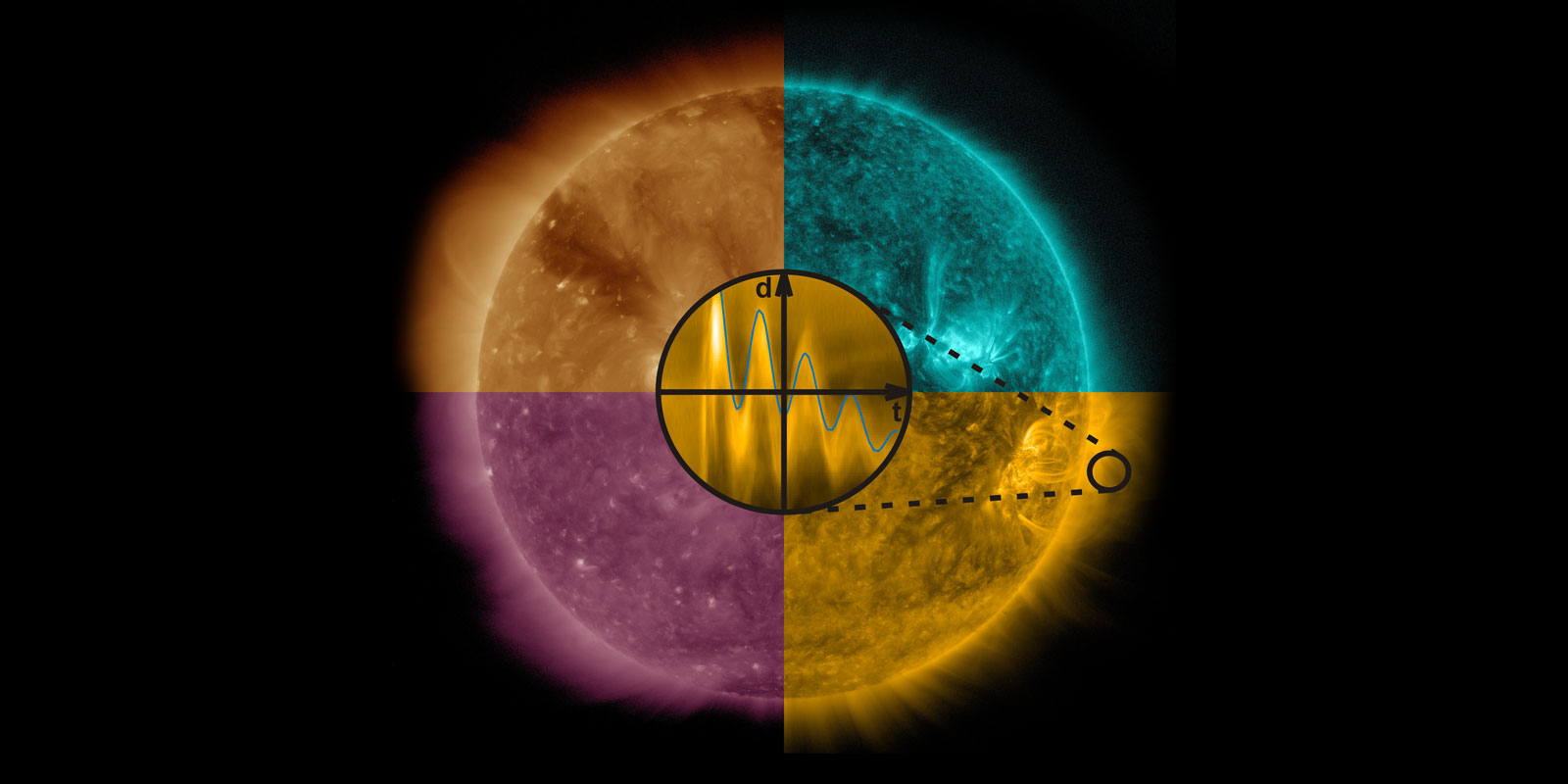
Picture credit: NASA/SDO and the AIA, EVE snd HIMI science teams
Date
October 14-18, 2019
OVERVIEW
Context
In 2019 there will be the 50th anniversary of the first detection of oscillatory processes in the solar corona as a quasi-periodic pulsation (QPP) of an X-ray and radio emission produced by a solar flare (Parks & Winckler, 1969). Nowadays, the study of oscillatory phenomena in the solar corona has reached its maturity. Coronal oscillations are detected and analysed in all observational bands, from radio to gamma-rays, and with ground-based and spaceborne instruments. The study of oscillatory phenomena is now considered as an important aim in almost every upcoming space mission dedicated to solar physics. Analysis and modelling of solar coronal oscillations and waves resulted in the successful implementation of the wave-based plasma diagnostic techniques (“magnetohydrodynamic (MHD) seismology”), contributed to the solution of the enigmatic problems of solar coronal heating and fast solar wind acceleration, and created a solid ground for the exploitation of solar-stellar and coronal-magnetospheric analogies.
The successful exploitation of the abundant information on oscillatory processes in the solar corona, obtained with the current generation of spaceborne and ground-based observational instruments (especially SDO/AIA, Hinode/EIS, STEREO/EUVI, NoRH and IRIS), and comprehensive theoretical numerical and analytical modelling, and the need for the identification of the future research avenues being opened up by the upcoming new generation of the solar instruments (Parker Solar Probe, DKIST, Proba-3 ASPIICS, ASO-S, Aditya, Solar Orbiter, Siberian Radio Heliograph, MUSER, InterHelioProbe, and ARKA) requires consolidated efforts of the international research community.
Objectives
This ISSI-BJ workshop will become a long-awaited forum gathering the most active researchers and promising young fellows in the field, which will allow us to summarise the main research achievements reached in the last decade, identify important gaps in our knowledge and discrepancies between observations and theory and the ways for their resolution, assess existing data analysis and modelling tools and approaches, and identify the most promising future research avenues in our research field. Putting the many recent results and new developments into the broader context of the physics driving plasma diagnostics based upon MHD oscillations is the next step, which will benefit from the combined efforts of theorists, observers and modellers working on a large variety of spatial scales, and spanning a wide range of expertise. We will specifically address future efforts in this field, both theoretically and observationally. In particular, the topics of the high priority are the exploitation of the complementarity of multi-instrumental and multi-wavelength observations, development and benchmarking of modern data analysis tools, accounting for the recently established nonlinear effects, and creating and using a link between analytical theory, numerical modelling and the interpretation of observations.
In addition, for the first time, we shall debate the solar-stellar analogy in the study of solar and stellar coronal oscillations, based on the recent detections of quasi-periodic patterns in stellar flaring energy releases with Kepler and XMM-Newton, and the striking similarity of the properties of those oscillatory patterns in solar and stellar flares. The identification of the solar-stellar analogy is especially timely now in the context of the TESS space mission.
An important outcome will be the publication of a Topical Issue of the Space Science Reviews and an ISSI monograph, summarising the current state-of-the-art in the field, identifying future research avenues, and reflecting on discussions on the proposed workshop.
The Workshop will cover the following main themes:
The workshop will cover a wide range of fields related to coronal physics:
- Seismology of coronal plasma structures,
- Novel data analysis techniques, addressing the intrinsically non-stationary nature of the observed oscillatory patterns,
- Nonlinear effects: manifestation in observations and theoretical modelling,
- Complementarity and exploitation of multi-instrumental and multi-wavelength observations,
- The similarity of quasi-periodic pulsations detected in solar and stellar flares, and its importance for revealing the mechanisms for those pulsations and the energy releases.
ProductFollowing the Workshop, Springer will publish its output as a volume in the Space Science Series of ISSI, in parallel with the publication of the papers in a Topical Issue of Space Science Reviews. It is expected that a total of about 7-8 multi-authors review style and quality papers, submitted to the usual refereeing process will be published in the book. Papers will be based on talks presented at the Workshop and will reflect the discussions that will be held among the participants during the Workshop.
Read the workshop press release here.
AGENDA
The links to the presentations displayed during the workshop can be found in the Presentations link below.
 Workshop Agenda
Workshop Agenda
Last update: October 12, 2019
 Workshop Handbook
Workshop Handbook
Last update: October 12, 2019
 Abstracts List
Abstracts List
Last update: October 12, 2019
PRESENTATIONS
 Presentations
Presentations
CONVENERS
| Valery Nakariakov |
University of Warwick, UK |
| Dipankar Banerjee |
Indian Institute for Astrophysics, India |
| Bo Li |
Shandong University, China |
| Tongjiang Wang |
NASA-Goddard Space Flight Center, USA |
| Ivan Zimovets |
Space Research Institute of RAS, Russia |
| Maurizio Falanga |
ISSI-BJ, China |